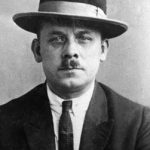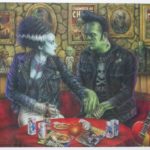Abstract
This article on clinical vampirism also known as Renfield’s syndrome presents an overview of this rare syndrome and gives perspective into clinical practice with a “vampire” client through a case study. Additionally, other people who drink animal blood and receive injections of their own blood for nutrition and health reasons are discussed. Implications and suggestions for further peer-reviewed articles and research studies are given. Clinical vampirism or Renfield’s syndrome is a mental illness characterized by an obsession with drinking one’s own blood (auto vampirism) and the blood of other humans and animals (zoophagia). Clinical vampirism is not recognized in the DSM-IV-TR (2000) as a separate disorder, and peer-reviewed literature and research are scarce, although clinical vampirism has been mentioned in psychological and fictional literature for many years (von Krafft-Ebing, 1886; Vanden Bergh & Kelly, 1964; Prins, 1985; Noll, 1992; Gubb, Segal, Khota, & Dicks 2006).
Renfield’s Syndrome
Renfield’s syndrome, also called clinical vampirism, is usually found in males: Clients are often diagnosed with a DSM-IV-TR psychiatric diagnosis such as schizophrenia or one of the paraphilias in the psychiatric arena based on their behavioral manifestations, such as delusions of being a vampire, fetishes, and compulsive blood-drinking. Hemphill and Zabow (1983) suggest that clinical vampirism is not considered a primary symptom of an Axis I psychiatric diagnosis or a primary symptom of a personality disorder on Axis II of the Diagnostic and Statistical Manual of Mental Disorders. This is evidenced in other professional publications as well (Prins, 1984; Gubb, Segal, Khota, & Dicks, 2006; O’Neal, 2009). Reports in medical literature on vampirism date back more than 100 years. These focus also on compulsive blood drinking, psychoses, a preoccupation and “an affinity with death” (O’Neal, 20009), in addition to medical disease etiologies for the origin ofvampirism (Jenkins, 2010). An intensive literature search and an Internet search of the Crime Library revealed that significantly more references to vampire ritualistic behaviors are found in criminal records (Miller, Veltkamp, Kraus, Lane, & Heister, 1999; O’Neal, 2009), crime literature and movies (Gabbard & Gabbard, 1987; Tucker, 1994), and in fictional literature such as Bram Stoker’s (1897) novel Dracula and Anne Rice’s 10 novels, the Vampire Chronicles, written between 1976 and 2003, than in peer-reviewed psychiatric or psychotherapy literature. Gubb et al. (2006) state, “Vampirism, regardless of the definition used, is rarely seen in clinical psychiatric practice,” and “references to the subject in professional texts have decreased since the 1940s and there is a paucity of research on the condition.” Most information on Renfield’s syndrome in professional publications is old.
Richard Noll (1992) is credited with first coining the term Renfield’s syndrome. Renfield, Count Dracula’s assistant, is a character in Stoker’s Dracula. Renfield ate flies, spiders, and birds because he longed for their life force.
It is thought that Renfield’s syndrome progresses in stages from licking or sipping one’s own blood (auto vampirism) to drinking animal blood and eating live animals (zoophagia) to true vampirism–that of drinking the blood of others (Noll, 1992). Blood drinkers seen in the clinical arenas believe that drinking blood gives them a sense of power and control (Noll, 1992) and that the blood is a life force they need. They often believe the fantasy that ingesting blood helps them gain immortality. Additionally, vital energy is infused back into them in the case of auto vampirism and infused from others in the case of true vampirism.
A seemingly similar phenomenon is also noted in the case of medicinal own-blood injections or own-blood therapy, sometimes seen in Europe. In German, this is called Eigenblut-Injektionen (Krebs, 2008). Vital energy and health are the reasons that many Europeans and those from other countries say they drink animal blood and have eaten blood “wurst” all their lives: to maintain their health and make them healthier. These people are not seen in the psychological arena. They are not considered “abnormal” and are not considered zoophaginists. They are apparently not sexually aroused when eating and drinking blood or receiving injections of their own blood. They are often seen in medical facilities for medical checkups or illnesses, and in marketplaces and meat stores selling blood “wurst” and in restaurants on slaughter day, when flesh blood “wurst” of different sorts are on the menu and considered nutritional delicacies.
Practices such as these do not support Noll’s (1992) notion that drinking blood breaks a cultural taboo on such practice and that breaking taboos is exciting; therefore, the process becomes rewarding. Considering cultural perspectives on the ingestion of blood, vampirism, where clients think they are vampires and practice vampiristic behaviors, must be differentiated from those who receive own-blood injections, drink blood, and eat coagulated blood for medicinal reasons or those who eat blood food products as delicacies. These people report that the taste of blood is not exciting. Most people–adults and children alike–who prick their finger, drawing blood, immediately put their finger in their mouth, also experiencing the taste of blood, but do not get aroused. Some professionals believe that this phenomenon has its roots in a psychophysiology (reflex) perspective and in a medical/survival perspective because saliva is a natural disinfectant that all humans and animals have (Oppawsky, personal communication, August 14, 2010). Dogs also lick their wounds, as the saying goes. Therefore, the acceptance of the taste or ingestion of blood can be understood as multifactorial with biological, sociological, and psychological roots.
A dearth of peer-reviewed professional psychological/psychotherapy/psychiatric literature and research of any kind exists on Renfield’s syndrome-clinical vampirism. One exception is Gubb et al.’s (2006) article, which includes a review of clinical vampirism with a well-written, detailed case study describing a different type of vampirism called “psychic vampirism.” Leaning on various Internet-site references, they write, “Psychic vampires are defined as the consumers of the energy of others, rather than their blood, or other bodily fluids, but still have the aim of taking the victim’s life-giving powers in order to sustain them without resorting to physical contact with the victim.” In a review of 25 psychological journals from 1950 to 2010, only a few references to psychic vampirism were found (Auerbach, 1995; Gubb et al., 2006). Gubb et al. affirmed that they “were unable to find a single case report of psychic vampirism in the professional literature.” One definition of psychic vampirism was found in the Encyclopedia of Metaphysical Medicine (1979). The definition included physical and sexual contact but not blood sipping or drinking. A few personal accounts found on the Internet in blogs and home pages from those who believe they are psychic vampires substantiate that some psychic vampires take the energy and power of others for themselves without physical contact with others, whereas others take these through bodily contact and sexual intercourse.
Vampirism and Psychological Theory
Professional psychiatric literature consistently associates Renfield’s syndrome with sexual arousal after puberty (McCully, 1964; Noll, 1992). Noll contends that an event in childhood in which contact with blood is found to be exciting–such as in an injury or drinking of blood–is a precursor for sexual arousal when in contact with blood after puberty. Gubb et al. (2006) write, “From a psychoanalytic perspective, vampirism is an aggressive sexual act with a libidinal component–whereby the drawing of blood from an object results in the vampire achieving sexual excitement and pleasure.” They cite Prins (1985) to support these notions. In criminal and fantasy literature on vampires, and some peer-reviewed professional literature, lust, identity problems, sexual excitement, sexual pleasures, masturbation, sense of well-being, empowerment, cruelty, sadism, obsession, power, control, life-enhancing powers, murder, killers, necrophilia, necrophagia, and blood fetish are common terms and themes (von Krafft-Ebing, 1886; Bierman, 1972; Berber, 1998; Jaffe & DiCataldo, 1994; Tucker, 1994; Gubb et al., 2006). Assessing these terms and notions, psychotherapists can make a good case for treating clients with clinical vampirism using a psychodynamic approach, or at least incorporating psychoanalytic thought in an integrative therapeutic approach, i.e. Bierman, Henderson, 1976; Steiner, 1993; Schlozman, 2000; and Gubb et al. Abraham (1925, 1960) espouses on oral eroticism (biting) in one’s character formation, and O’Neal (2009) reports, “Vampirism and sexual behavior are clearly linked,” remarking that “the ‘love bite,’ which is considered normal and a fairly common sign of affection, should be an interesting topic of discussion among sexual assault nurse examiners and other investigators who examine bite marks.” Freud (1960) purports that in the oral phase, sexual energy is on the mouth, tongue, and lips. Melanie Klein writes about aggressive fantasies in a number of her publications, e.g. in her book Contributions to Psychoanalysis, 1921-1945. Gubb et al. (2006) also report on Fairbairn’s (1946) writings on the development of object-relationships, and in the case of maternal deprivation, “An oral sadistic libidinal need is formed.”
The psychoanalytic perspective theorists tend to trace the etiology of clinical vampirism to early conflicts in child development and/or traumatic relationships. Millon (1987), who wrote about the etiology of personality disorders and various schizophrenic and psychosomatic disorders from an analytic perspective, defined these as “… splitting or repressing of introjected aggressive impulses engendered by parental hostility, an intrapsychic mechanism requisite to countering the dangers these impulses pose to dependency security, should they achieve consciousness or behavioral expression.” Learning theory perspective theorists would concede to the notions of early conflict and traumatic relationships as templates for later problems but add that behaviors need continuous replication and reinforcement to become pervasive clinical symptoms (Fisher & Greenberg, 1977; Millon, 1981). A link between observable phenomena of a client with clinical vampirism and psychoanalytic theory, which focuses on the client’s internal experiences in childhood, can serve as a starting point for an integrative biopsychosocial model of understanding clinical vampirism and treatment.
A cognitive-behavior brief treatment therapy was chosen to augment the ongoing mental health case management and psychiatric care afforded the client in the following case study to help the client attain his goals to stop drinking his own blood and the blood of others. The client was not interested in or felt the need to delve into his childhood, and to do so could have resulted in non-compliance with or early termination of therapy. Additionally, proposing a treatment goal of “getting over vampirism” would have severed the therapeutic alliance, resulting in termination of therapy.
The Case Study
Vladimir B. (name changed), Vlad for short, a tall, thin Caucasian 36-year-old male, entered the therapy room dressed in black from head to toe. He had on a black bandanna and wore black sunglasses in black frames. He wore a black long-sleeved shirt, black pants, and black shoes and socks. He wore a black fanny pack around his waist. When asked if he came on his bike, he said, “No, I’m a vampire.” In a provocative tone, he said that the fanny pack held his vampire paraphernalia. He immediately opened the pack’s zipper and exposed the contents. The pack contained a black tourniquet, a few sterile needles, two thin red rubber tubes and one clear plastic tube about 12 inches long. Each tube had a plastic mouthpiece in one end that looked used and a pipette in the other end that fit into the top of the needles in which syringes usually go. He said, in a tone that conveyed his self-assessment of uniqueness, or perhaps nervousness, “I bet you haven’t met anybody that likes and drinks blood and is a vampire.” Based on his behaviors and comments, it appeared that his actions were meant to shock. He showed surprise when I disclosed (without revealing that I had not met a vampire) that I knew a number of people and had psychotherapy and nursing clients who liked and drank blood because I had studied, lived, and worked abroad for many years, where drinking blood and eating blood food products were thought to be very healthy. There, these were frequent and natural occurrences. This disclosure helped establish a therapeutic relationship with Vlad and is evidence of the importance of cultural awareness, experience, and competencies of therapists.
Fragments of the Biopsychosocial
Vlad grew up as an only child of a farmer and butcher and his wife, both deceased. He remembers his father as loud with boisterous behaviors and crude, but friendly and affectionate in a rough sort of way: “He gave me a pat now and then;” “he never kissed me.” He reported his mother was cold and distant, never touching him that he can recall and never smiling. He remembers that his father drank a shot of fresh blood once or twice a week when he slaughtered the animals and boiled the innards, brain, lung, heart, breast glands, spleen, stomach, kidneys, and liver. He also sliced raw liver very thin and ate that. He made Vlad drink a shot of fresh blood on those days and eat a small slice of raw liver because he was “anemic.” He was not forced to eat the innards, but he liked sausage that was put into cleaned intestinal casings. He could not remember liking the blood or liver. He denied any sexual arousal connected with this.
By his history and his documented medical history, Vlad had his first schizophrenic break when he was 21. During that early time, he hallucinated and had various delusions, none vampiristic in nature. He had been on a plethora of psychotropic medications and was compliant on risperidone (Risperdal) and stable at the time of the biopsychosocial assessment. He was in continual psychiatric and case management care for the seriously mentally ill, funded by his managed care provider. He reported being exposed to vampirism for the first time in the “mental health scene.” He was “invited” to participate with five other men who considered themselves to be vampires, tapping and drinking their own blood, eventually drinking each other’s blood. “I immediately became a vampire. It was like this was what was missing,” he said. Vlad found the ingestion of blood to be exciting. He became sexually aroused and believed he felt a sense of power over himself and in control of himself. He felt invincible for the first time since he was diagnosed with schizophrenia. Soon, the ritual of drinking his own blood with the men only gave him temporary satisfaction, and he started drinking the blood of the other men. He reported addict-like behavior resulting from his need for blood, but he only associated with and drank the blood of those five men and his own blood. He reported that they all became sexually aroused while drinking each other’s blood but that there was no homosexual activity between them. In fact, he was having regular heterosexual contact with his fiancee. He liked to speak of vampirism, rent vampire movies and read vampire literature containing cannibalism, lust-murder, cruelty, and criminal activity, but he was never criminal and did not have these proclivities himself.
Vlad was seeking individual therapy in addition to his ongoing psychiatric and case management care because he had become intensely frightened of AIDS. He had two negative anonymous AIDS tests. He also was engaged to be married, and his fiancee, who knew about his vampirism, wanted him to stop drinking his own blood and the blood of others. He was not willing to give up being a vampire, but he was willing to stop drinking blood. He had already stopped meeting with the men and was down to drinking his own blood “once or twice a week.”
Vlad was a longtime member of the seriously mentally ill (SMI) community and had been assigned different case managers over the years. Case managers and psychiatrists manage the needs of these patients but do not do psychotherapy. Up to this point, his delusions and compulsive blood drinking behaviors were embedded in his diagnosis of schizophrenia. He had never received individual or group therapy for this self-defined “compulsive” behavior. As a result of his own request for individual therapy to stop his behaviors, his managed care insurance provider authorized six sessions of individual therapy in addition to his ongoing mental health case management and psychiatric sessions to help him deal with his “addictive behavior” and his “compulsive blood-drinking behavior.” His individual therapy sessions could be weekly, biweekly, or monthly. The client and I chose monthly sessions because of the nature and severity of the compulsions and because of his impending marriage in six months. He wanted to have “this condition” under control. This schedule guaranteed him 180 days of commitment to individual therapy rather than 45-90 days. The time frame also gave the client time between sessions to practice abstinence in vivo and to use his strong motivators of his impending marriage and marriage planning to help him accomplish his treatment plan goals. A cognitive-behavior therapy modus was chosen to support his changed cognitions about the unhealthiness of drinking others’ blood, which seemed tenuous to me, and because he had already reduced his vampiristic behaviors to auto vampiristic ones as a result. The goals of therapy were zero auto vampiristic activity and zero true vampiristic activity by the end of three months and long-term abstinence from both activities. To rid the client of the belief that he was a vampire was not a goal of therapy. Although I did not know about psychic vampirism at the time of treatment, I thought that trying to strip the client entirely of his vampirism was therapeutically prohibitive and would lead to unsuccessful attempts to control his compulsions and to early termination of therapy.
At the beginning of therapy, the client had already stopped meeting with the other five men and drinking their blood. This continued throughout his therapy. When therapy commenced, the client reported that he was tapping and drinking his own blood about two times a week. The client stated that he reduced this behavior in the first month of therapy to occasional auto vampirism and stopped entirely in the second month of therapy. He reported that he had no bloodletting or blood drinking behaviors by the third session (three months) and wanted to come to therapy weekly or biweekly for the remainder of the six sessions so that he could terminate therapy after the fourth month. After the first session, he never wore his “vampire” outfit again to therapy. After termination, he reported no further bloodletting or blood drinking behaviors in follow-up calls one month and two months after termination of his individual therapy. Another AIDS test had been negative.
Discussion
Vlad was exposed to animal blood and had consumed animal blood and food products made of animal blood since childhood. Although his biopsychosocial information indicates that he fits the predisposing criteria for Renfield’s syndrome recognized in professional literature, such as exposure to and ingestion of blood at an early age, and he had experienced a distant and cold mother-child relationship, he never became sexually aroused nor found abnormal pleasure in these practices as a child or adolescent. “All of it was just normal.” This is also reported by medical patients and psychotherapy clients who partake in these practices for medicinal and nutritional (health) reasons. Their behaviors are also “normal” from a cultural perspective.
His first exposure to vampirism was through mental health clients in the seriously mentally ill population. His interest in mystery novels and “scary shows” intensified, as did his interest in reports on criminal cases that involved psychosexual pathology during his association with his “friends.” He was not criminal himself. Drinking his own blood, and later the blood of the others, gave him a sense of self-determination and self-control that he did not feel trying to deal with the ups and downs of a serious mental illness. He felt empowered. Schizophrenia made him feel out of control of himself and his life and helpless most of the time. These out-of-control and helpless feelings could be similar to those feelings experienced in childhood because of his mother’s lack of care and attention suggesting an unresolved crisis in object relations in childhood. Expressed in psychodynamic terms, these feelings were similar to the pain of maternal object loss he experienced in childhood with a cold and distant mother. Drinking blood in adulthood put him in control of himself, empowered him, and made him feel energized. He took energy from others and sucked life-giving powers from others for himself, securing for himself what was missing in childhood–finishing an unfinished crisis in object relations. He also was sexually aroused when drinking blood as an adult. These propelling and compelling experiences reinforced his behavior and kept him going back for more. Additionally, the introduction to the individuals who drank their own blood and each other’s, and to being sexually aroused by doing so, resulted in his having a “peer group,” being accepted, and feeling “normal”–all expected emotions of developing peer groups during adolescence. Had it not been for his involvement with mental health services, he very well may not have had this cultural experience.
Two pivotal events motivated Vlad to stop meeting with the other men and drinking their blood and would be motivators to stop his auto vampirism. They were his engagement to be married and his intense fear of AIDS. He would give no specific reason for this intense fear of AIDS other than to say it is fatal. He could give up his feelings of helplessness and feeling out of control without blood because he had a replacement–a relationship, which would result in marriage–and because of his own strength, propelled by his fear of contracting AIDS, to fight against getting AIDS by giving up blood. A cognitive-behavioral therapy approach was indicated because the client was not interested in or felt the need to delve into his childhood. This raised some questions about the accountability and accuracy of the role of childhood and adolescent experiences and relationships given by the client and the role exposure to and the use of blood at a very early age played in the development of his delusional material. These questions also gave credence to my incorporating psychodynamic thoughts and queries into the case conceptualization.
The client was highly motivated to change his behaviors. In itself, his asking for and receiving six months of therapy in six sessions indicated his motivation. He was open to reducing his blood use to zero and maintaining long-term abstinence. He immediately developed a time frame for reduction of use and abstinence and a reward plan for compliance. That I did not appear shocked at his “vampirism” and had cross-cultural clinical experience with people who ingested blood in one form or another, or who had interest in and received Eigenblut Injektionen, helped to establish a therapeutic working relationship from the start of therapy. This experience underscores the importance of cultural competence of therapists and cultural relevance in the diagnosis of mental disorders. Additionally, not proposing a treatment goal of “getting over vampirism” impressed him. Trying to strip him of his “vampirism” would have led to non-compliance and early termination. From a psychodynamic perspective, stripping him of his “vampirism” would have left his ego unprotected and fragile if he had development his “vampirism” as a defense mechanism.
Implications and Suggestions for Further Research
As cited above, a dearth of peer-reviewed articles and research on clinical vampirism or Renfield’s syndrome and psychic vampirism exists. The few peer-reviewed articles available are mostly singular case studies such as the “illustrative case report” by Gubb et al. (2006) or theoretical formulations. Some articles focus on criminal activity and contain re-evaluations of information on serial killers.
I believe that there is a hidden number of people who participate in vampiristic activities and consider themselves vampires. An interesting research project would be to investigate the prevalence of vampiristic behaviors in a large seriously mental health population, because the records of the managed care provider to this population are numerous, often in the thousands, up-to-date, and complete. Basic information on prevalence could be obtained by an anonymous questionnaire acquired from that population to start the research.
Additionally, cross-cultural practices on drinking animal blood and eating animal parts and getting Eigenblut Injektionen–injections of one’s own blood–should be researched. The results of these studies could be related to vampiristic practices. Questions arise, such as how are closely are nutritional/health blood ingestions related to vampiristic practices, if at all. What are the differences between this client and those who drink blood to gain and maintain strength and health? Other research questions arise concerning people who claim to drink the blood of Christ. Is that psychic vampirism? How do therapists assess the cultural practices of people who drink blood or figuratively drink blood? Questions about connections to cannibalism and the spiritual practice of cannibalism in a cross-cultural context arise and need to be researched. How does one assess the meaning of these practices? Are these practices healthy or not? Also, a research project that gave psychological and personality testing to a population of people who drink blood or receive Eigenblut Injektionen for medicinal reasons or to maintain their health or make them healthier would be interesting. This group should also include those people who eat fresh blood food products or eat raw, bloody meats considered nutritional delicacies. Spikes in areas of an assessment, such as in the MMPI, which are associated with vampirism would indicate the need for further research between these groups. These, among other comparisons between those people who have confirmed vampiristic behaviors and those who consider their uses of blood “normal” practice, would be needed research projects. These studies, among others, could help clinicians who work on revisions for the Diagnostic and Statistical Manual of Mental Disorders (American Psychiatric Association, 2000) determine the need for a diagnostic label of clinical vampirism. A diagnostic label of clinical vampirism would give clients a chance for individual therapy sessions if clinical vampirism were no longer embedded in other mental disorders usually covered only by case management and psychiatric services. Moreover, a fine line between normal and abnormal behaviors could be further differentiated. Peer-reviewed articles and research on Renfield’s syndrome would promote awareness among therapists of a possible hidden number of clients who may participate in vampiristic behaviors.
References
Abraham, K. (1925). Psychoanalytische studien zur charakterbildung [Psychoanalytic studies of character development]. Institut fuer Psychoanalysis: Verlag.
Abraham, K. (1960). The influence of oral eroticism on character formation. In: Selected papers on psychoanalysis. New York: Basic Books, 396-406.
Auerbach, N. (1995). Our vampires, ourselves. Chicago, IL: University of Chicago Press.
American Psychiatric Association (2000). Diagnostic and statistical manual of mental disorders (Revised 4th ed.) Text Revision. Washington, D.C.: author.
Berber, P. (1998). Forensic pathology and the European vampire. In A. Dundes (Ed.) The vampire: A casebook. (pp. 109-142). Wisconsin: The University of Wisconsin Press.
Bierman, J. S. (1972). Dracula: prolonged childhood illness and the oral triad. American Imago 29, 186198.
Fairbairn, W. R. D. (1946). Object-relationships and dynamic structures. International Journal of Psychoanalysis, 22, 30-37.
Freud, S. (1960). A general introduction to psychoanalysis. New York: Washington Square Press.
Fisher, S., & Greenberg, R. P. (1977). The scientific credibility of Freud’s theories and therapy. New York: Basic Books.
Gabbard, K., & Gabbard, G. D. (1987). Psychiatry and the cinema. Chicago, IL: University of Chicago Press.
Gubb, K., Segal, J., Khota, A., & Dicks, A. (2006). Clinical vampirism: a review and illustrative case report. South African Psychiatry Review, 8, 163-168.
Hemphill, R. E., & Zabow, T. (1983). Clinical vampirism: a presentation of 3 cases and a re-evaluation of Haigh, the “acid bath murder.” South African Medical Journal, 63(8), 278-281.
Henderson, D. J. (1976). Exorcism, possession, and the Dracula cult: a synopsis of object relation psychology. Bulletin of the Menninger Clinic, 40, 603-628.
Jaffe, P. D., & DiCataldo, F. (1994). Clinical vampirism: blending myth and reality. Bulletin of the American Academy of Psychiatry Law, 22(4), 533-544.
Jenkins, M. C. (2010). Vampire forensics: Uncovering the origins o fan enduring legend. Washington, D.C.: National Geographic Press.
Krebs, H. (2008). Praxis der Eigenbluttherapie [Own-blood therapy practice). Munich, Germany: Elsevier GMBH, Urban and Fischer Verlag.
McCully, R. S. (1964). Vampirism: historical perspective and underlying process in relation to a case of auto-vampirism. Journal of Nervous and Mental Disease, 139(5), 440-452.
Miller, T., Veltkamp, L., Kraus, R., Lane, T., & Heister, T. (1999). An adolescent vampire cult in rural America: clinical issues and case study. Child Psychiatry and Human Development, 29(3), 209-219.
Millon, T. (1981). Disorders of personality. New York: Wiley-Interscience.
Millon, T. (1987). On the genesis and prevalence of the borderline personality disorder: A social learning thesis. Journal of Personality Disorders, 1(4), 354-372.
Noll, R. (1992). Vampires, werewolves, & demons: Twentieth century reports in the psychiatric literature. New York, New York: Brunner/Mazel Publishing, Inc.
O’Neal, B. J. (2009). Human living vampires: what investigators need to know. Forensic Nurse. Retrieved from http://www.forensicnursemag.com/articies/351lifedeath.html.
Prins, H. (1984). Vampirism: legendary or clinical phenomenon? Medical Science Law, 24(4). 283-293.
Prins, H. (1985). Vampirism–A clinical condition. British Journal of Psychiatry, 146, 666-668.
Schlozman, S. (2000). Vampires and those who slay them. Using the television program Buffy the Vampire Slayer in adolescent therapy and psychodynamic education. Academic Psychiatry, 24, 49-54.
Steiner, J. (1993). Psychic retreats: pathological organization in psychotic, neurotic and borderline patients. London, England: Routledge Press.
Stoker, B. (1897). Dracula. New York: Modern Library. Tucker, W. M. (1994). Teaching psychiatry through literature: the short story as case history. Academic Psychiatry, 18, 211-219.
Vanden Bergh, R. I., & Kelly, J.F. (1964). Vampirism: A review with new observations. Archives of General Psychiatry, 11, 543-547.
Von Krafft-Ebing, R. (1886, 1997). Psychopathia sexualis. [Sexual pathology] (14th ed.) Berlin, Germany: Matthes & Seitz Verlag.
By Jolene Oppawsky, PhD
JOLENE OPPAWSKY, PhD, a Diplomate psychotherapist and Ii-I censed professional counselor in Arizona and an approved clinical supervisor, is a University of Phoenix faculty member and supervisor in the graduate counseling program in Tucson, Arizona. Formerly, she taught for Boston University in its graduate overseas counseling program. She has taught psychology and psychotherapy at the University of Warsaw and at the University of Lithuania. She practices psychotherapy on a contract basis in Tucson, Arizona, and she has several professional publications to her credit.
COPYRIGHT 2010 American Psychotherapy Association








